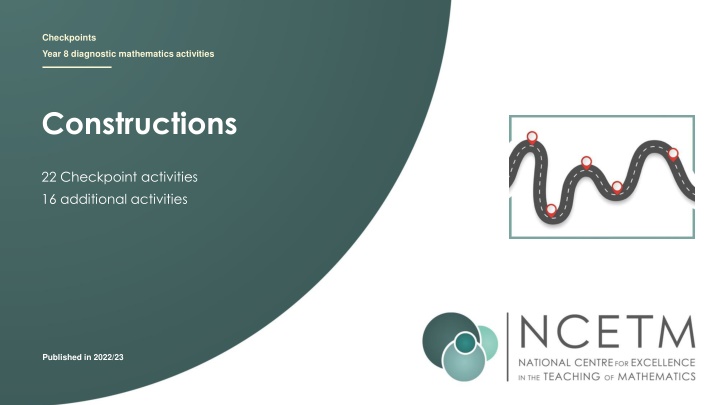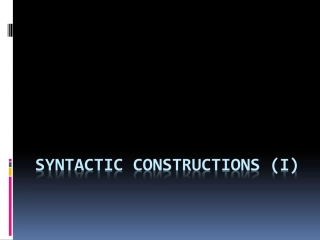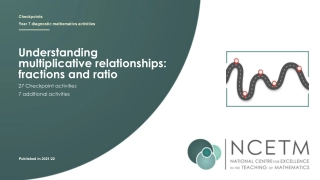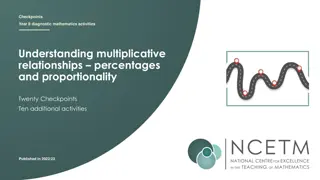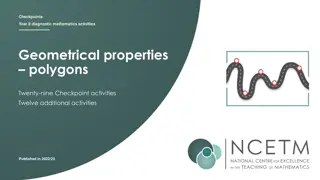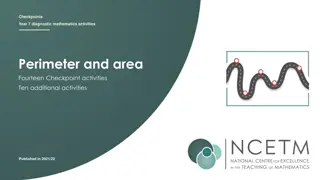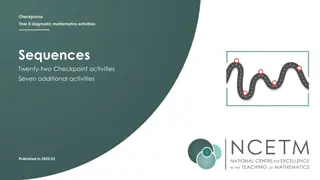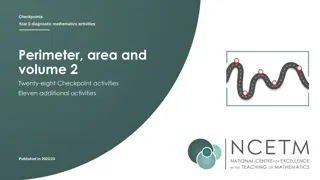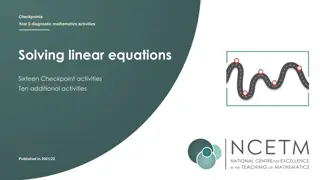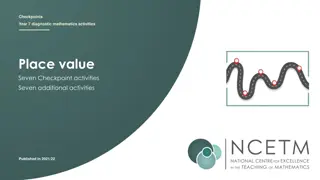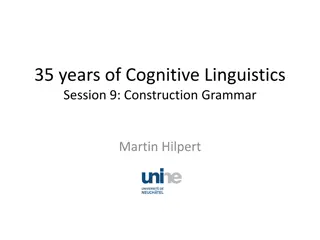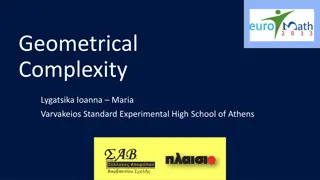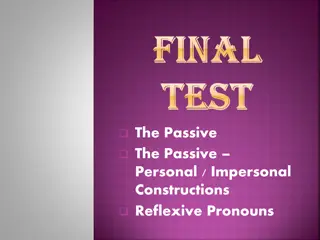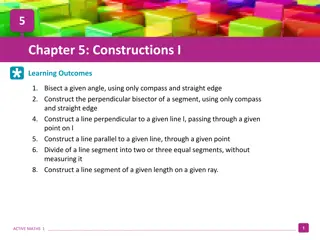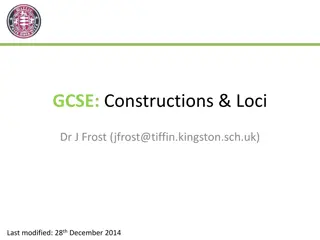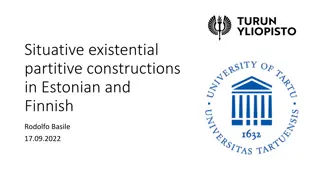Year 8 Diagnostic Mathematics Constructions Activities - Checkpoints 1-8
Engage with a series of 22 Checkpoint activities and 16 additional activities focusing on constructions in mathematics for Year 8 students. Published in 2022/23, the topics range from basic Circle constructions to more complex arrangements involving multiple circles. Each Checkpoint explores a different aspect of construction, ensuring a comprehensive understanding for students.
Download Presentation

Please find below an Image/Link to download the presentation.
The content on the website is provided AS IS for your information and personal use only. It may not be sold, licensed, or shared on other websites without obtaining consent from the author.If you encounter any issues during the download, it is possible that the publisher has removed the file from their server.
You are allowed to download the files provided on this website for personal or commercial use, subject to the condition that they are used lawfully. All files are the property of their respective owners.
The content on the website is provided AS IS for your information and personal use only. It may not be sold, licensed, or shared on other websites without obtaining consent from the author.
E N D
Presentation Transcript
Checkpoints Year 8 diagnostic mathematics activities Constructions 22 Checkpoint activities 16 additional activities Published in 2022/23
Checkpoints 18 1Checkpoint 1: Circle? Underpins Code 2: Perfect circle? 3: Three circles 4: Too many circles Using properties of circles in construction 6.4.1 5: Arcs 6: Making triangles 7: Ripples 8: Matching circles *This three-digit code refers to the statement of knowledge, skills and understanding in the NCETM s Sample Key Stage 3 Curriculum Framework (see notes below for more information).
Checkpoints 916 Checkpoint Underpins Code 9: Dangerous distances 10: Bungling burglars 11: Relocation Using properties of circles in construction 6.4.1 12: Celia saw 13: Fireworks 14: Making shapes 15: Impossible triangles Using properties of polygons in construction 6.4.2 16: Diagonally *This three-digit code refers to the statement of knowledge, skills and understanding in the NCETM s Sample Key Stage 3 Curriculum Framework (see notes below for more information).
Checkpoints 1722 Checkpoint Underpins Code 17: Tree branches 18: More ripples 19: Two sides and a diagonal Using properties of polygons in construction 6.4.2 20: Rhombus 21: Shortest distance 22: Where do you stand? *This three-digit code refers to the statement of knowledge, skills and understanding in the NCETM s Sample Key Stage 3 Curriculum Framework (see notes below for more information).
Using properties of circles in construction Checkpoints 1 13
Checkpoint 1: Circle? Anne says, The circle is black. John says, The circle is grey. Who is correct: A Anne B John C both Anne and John D neither Anne nor John? Dan says that the answer is D because you need more information about the circle to recreate it accurately. What information might you give?
Checkpoint 2: Perfect circle? A teacher asks her class of students to each draw a cross that is 5 cm from the dot. a) Did they all do this correctly? How do you know? b) What do you think would happen if the teacher asked more students to draw crosses 5 cm from the dot? How would the students responses be different if they were asked to draw 5 inches from the dot? How about 5 mm?
Checkpoint 2: Perfect circle? (solutions) A teacher asks her class of students to each draw a cross that is 5 cm from the dot. a) Did they all do this correctly? How do you know? b) What do you think would happen if the teacher asked more students to draw crosses 5 cm from the dot?
Checkpoint 3: Three circles The biggest (yellow) circle has a radius of 6 cm. The next biggest (red) circle has a diameter of 6 cm. The smallest (pink) circle has a radius of 2 cm. The dotted path goes through each circle s centre. a) How long is the dotted path in total? The dotted path is made from six straight lines. b) Is it possible to draw a path on the diagram that s the same length in total, but uses five straight lines? How about four? Draw your own 20 cm path using four circles of different radii. How many ways can you do this?
Checkpoint 4: Too many circles All these circles have a radius of 3 cm. For parts a to f, decide whether the points are more than 3 cm apart, less than 3 cm apart or exactly 3 cm apart. a) A and B b) A and N c) N and M d) C and K e) K and L f) F and H A to N to M M to L to C C to L to K I to H to G N to L to K L to N to A Are the paths on the right more than 6 cm long, less than 6 cm long or exactly 6 cm long?
Checkpoint 5: Arcs W, X, Y and Z are arcs from four circles with a radius of 5 cm. A, B, C and D are four possible centres for these circles. Match the arcs to their centres. What is your strategy? W X B A C D V A fifth arc, V, is drawn. It shares its centre with one of the other arcs but has a different diameter. Which point is the centre? Is the radius greater or less than 5 cm? Z Y
Checkpoint 6: Making triangles On the right are six line segments. They need to be arranged into two triangles. a) Is this possible? Why or why not? b) If it is not possible, what would you change to make it possible? 1 cm 3 cm 3 cm 3 cm 4 cm 7 cm Draw your two triangles. How can you do this accurately?
Checkpoint 7: Ripples Circles are drawn around points X and Y. The smallest circle around each has a radius of 1 cm. Each radius increases by 1 cm for each new circle. X is joined to Y with a line segment, and then both are joined to one other point to make a triangle. Which of the points A to F would make: a) an isosceles triangle b) a triangle with an obtuse angle c) a triangle with one length of 3 cm? F B C X A Y E D A triangle is made from X, Y and a new point G. One length is 5 cm, and one length is 2 cm. Where could its point be? Is there more than one answer?
Checkpoint 7: Ripples (solutions to further thinking question) A triangle is made from X, Y and a new point G. One length is 5 cm, and one length is 2 cm. Where could its point be? Is there more than one answer? F B C G X G A G Y G E D
Checkpoint 8: Matching circles Two circles, with centres X and Y respectively, have the same radius. a) Are all points in region B closer to point X or point Y? b) How about the points in region C? c) How about the points in region A? X Y Both the circles have a radius 3 cm. Where on the diagram is exactly 3 cm from both X and Y? How do you know?
Checkpoint 9: Dangerous distances In 2021, an unexploded World War II bomb was uncovered in Exeter. A 400 m cordon was put in place around the bomb site, while a controlled explosion was carried out. a) How might you describe the shape of the boundary of the safe region around the bomb site? How accurate can you be? Some sharks can smell blood from up to 400 m away. b) How might you describe the shape of the boundary of the safe region around a shark in the ocean? How accurate can you be? c) How is this the same and how is it different from the 400 m safe zone around the bomb site? Can you think of some other examples of safe zone boundaries that would have similar shapes? How about different shapes?
Checkpoint 10: Bungling burglars A burglar sets off the alarm at 17 Paultow Road. It is heard by everyone in a radius of 20 m (shown by the circle around the house). a) In which houses do people hear the alarm? b) In which houses do people hear the alarm most loudly? The burglar then sets off another alarm at 8 Paultow Road (shown by a second circle). c) In which houses do people hear both alarms? d) Which alarm is heard in the most houses? Why? A third alarm can be heard in all the houses on Durnford Road but none of the houses on Paultow road. Where might this alarm be?
Checkpoint 11: Relocation This is a map of Cornwall. The grid shows 5 km squares. Darren wants to live within 5 km of Penzance. a) Where could Darren live? He widens his search to within 15 km of Penzance. b) Where could he live now? c) Is it possible to also live within 15 km of Penryn? X X Darren buys a house exactly 10 km from Penzance. He drives from his new house to Penzance. What do you estimate the distance he travels to be? Why?
Checkpoint 11: Relocation (solutions to parts a and b) This is a map of Cornwall. The grid shows 5 km squares. Darren wants to live within 5 km of Penzance. a) Where could Darren live? He widens his search to within 15 km of Penzance. b) Where could he live now? X Darren could live anywhere on land within the circles shown.
Checkpoint 12: Celia saw Celia is watching Rom and Sam play on a see-saw. Which of the lines A to D shows the path that Rom moves? How do you know? B A D C In the playground, there is also a zip wire, swing and slide. Draw the path that Rom would take on one of these.
Checkpoint 13: Fireworks At a fireworks display, the crowd needs to be at least 25 m from the fireworks. The fireworks are positioned in the circular area around X. There are three options for the position of the safety fence and the crowd. a) Which is the best option for the position of the fence? Why? b) Could you create a better fence position? What would be the optimal position of the fence if the fireworks were set off from a different position? How about if the fireworks area looked like this? X
Checkpoint 13: Fireworks (solution to part b and further thinking question) b) Could you create a better fence position? How would the position of the fence need to change if the fireworks were set off from a different position? How about if the fireworks area looked like this?
Using properties of polygons in construction Checkpoints 14 22
Checkpoint 14: Making shapes a) Use a ruler and protractor to construct these shapes. A square with side length 4.5 cm A rhombus with an angle of 35 An isosceles triangle with an angle of 50 and a side length of 60 mm b) Did you have enough information to do this? Is there more than one way to do any of them? What additional information would you need each time to ensure there was only one possible shape for each instruction?
Checkpoint 15: Impossible triangles 100 Priya uses a ruler to draw the triangle on the right. She then measures the angles with a protractor. Paani says that Priya s angle measurements are not possible. a) Who is correct? 40 100 Paani measures and re-labels the incorrect angle. b) Use a ruler and a protractor to draw the triangle accurately. c) What are the missing measurements? 25 Make a different triangle using 8 cm, 9 cm and 100 . Is one of the missing angles still 25 ?
Checkpoint 16: Diagonally Ms Astley asks her class to draw a square and its diagonals. On the right are two students responses. a) Who is correct? Why? b) What do you notice about the two correct diagonals? c) Do any other shapes have diagonals like this? Greta Felix In another shape, two diagonals are of equal length and meet at right angles. What other property would they need to form a kite but not a square?
Checkpoint 17: Tree branches Find: a) b) a pair of perpendicular line segments a pair of line segments where one cuts the other in half a pair of perpendicular line segments where one cuts the other in half. c) Add one line segment so that there is another solution to each of parts a c. How many ways is it possible to do this?
Checkpoint 18: More ripples Circles are drawn around points X and Y. The smallest circle around each has a radius of 1 cm. Each radius increases by 1 cm for each new circle. X is joined to Y with a line segment to form one diagonal for a quadrilateral. Two points from A, B, C and D will be connected to make the other diagonal. a) Is it possible to make a kite? Why or why not? b) How about a rhombus? Why or why not? F B C X A Y E D Where would you plot one more point to create a kite? What about a rhombus? Is there more than one way to do this for each shape?
Checkpoint 19: Two sides and a diagonal Some of diagrams A to E show two sides and a diagonal of a rhombus. a) Which ones do you think they are? b) How could you be sure? E C A B D Draw your own diagram that shows two sides and a diagonal of a rhombus. What properties do your lines need to have?
Checkpoint 20: Rhombus On the left is a rhombus with its diagonals drawn on. The angle between one diagonal and one side is labelled. a) What other angles do you know? 75 On the right is another rhombus with just one diagonal drawn on. One angle is labelled. b) What is the missing angle r? How do you know? r 88 How many facts can you write about the relationship between the angles and diagonals in a rhombus?
Checkpoint 21: Shortest distance A Road A and road B are parallel. The council are planning to build a straight road to connect the roads. Four possible routes are shown as black lines. a) Which possible route will be the shortest when it reaches road B? b) Could they make an even shorter route? How? 76 111 84.5 99.2 1 2 3 4 B Imagine the lines for the possible routes are extended above and below roads A and B. Which pairs of lines will cross above road A? Which will cross furthest from the road?
Checkpoint 22: Where do you stand? x Flo x Abi Two stink bombs, A and B, are set off in the school hall. Five students stand so that they are equidistant from both stink bombs. a) What do you notice about the positions of the students? b) Who is closest to the smells? c) Who is furthest from the smells? d) Flo enters the room. Which smell is she closest to? e) If you were also in the hall, where would you stand to be least affected by the smells? x Bix B x Cam A x Dev x Eli Draw this image as accurately as you can. What equipment will you need to do this?
Additional activities Activities A P
Activity A: Square and circle a) b) c) Draw a 3 cm square. Draw a 3 cm circle. What is the same and what is different about how you followed these instructions? Think about some different shapes. What are the key measurements you need to give so that someone could draw them? How do these measurements compare to what you need to give to describe a circle?
Activity B: Quay points a) Put the bricks A, B and C in order of their distance from the central stone, the closest first. b) How do you know which points are further away? C B A How might this pattern of bricks have been laid? How would you arrange bricks to be sure they would form a circle?
Activity C: Target The smallest circle (A) has a radius of 1 cm. Each circle has a radius that is 1cm bigger than the one before. a) Complete the sentences below. Is there more than one way to do this? Circle __ has a diameter of 4 cm. Circle __ has a radius of 4 cm. Circle __ has a radius of __. Circle __ has a diameter of __. b) Find a point that is more than 3 cm but less than 4 cm from the centre. And another. And another. c) Mark all the places that are more than 2cm but less than 4 cm from the centre. A B C D E How would your answers to b and c change if the shapes were concentric squares rather than circles?
Activity D: Sorting distance The larger circle has a radius of 4 cm. The smaller circle has a diameter of 4 cm. The dot is the centre of both circles. a) Organise the letters into the following table: D A K C M J Less than 2 cm from the dot Between 2 and 4 cm from the dot More than 4 cm from the dot G L F B E b) Which letters could you not organise? Why? H Imagine a circle of radius 2 cm drawn with a centre at L. Which points would also be within or on this circle?
Activity E: Just the right number of circles All these circles have a radius of 3 cm. For parts a to f, decide whether these points are more than 3 cm apart, less than 3 cm apart or exactly 3 cm apart. a) A and B b) B and C c) C and F d) D and F e) E and D f) F and E Point P is exactly 3 cm from D and exactly 3 cm from E. Where could P be if it is also less that 3 cm from F? How would your answer change if it was more than 3 cm from F?
Activity E: Just the right number of circles (solutions to further thinking question) Point P is exactly 3 cm from D and exactly 3 cm from E. x P x P How would your answer change if it was more than 3 cm from F? Where could P be if it is also less than 3cm from F?
Activity F: Even more ripples Circles are drawn around points X and Y. The smallest circle has a radius of 1 cm. Each new circle has a radius that is 1 cm bigger than the previous one. For each of the points in parts a to f, state how far it is from points X and Y: a) A b) B c) C f) F B C X A d) D e) E Y F E D Mark all the points where circles with the same radius intersect. What do you notice?
Activity G: Circles The line on the left is the radius of a circle. a) Where is the centre of the circle? Where is the circumference? b) How would your answers to part a change if the line was the diameter of the circle? The line on the left is the arc of a circle. c) Which of points A to D is the centre for the arc on the left? How can you check? BCD A How might you find the centre of a circle if there was not one marked?
Activity H: Flower power A Six dots are equally spaced around the circle. Polly uses one of the dots to draw this arc with a pair of compasses. a) Which dot did she use? How do you know? Polly uses another dot to draw a second arc. It touches but does not cross the first arc. b) What does this tell you about the circles in the diagram? c) What will happen if Polly draws an arc from every dot? B F E C D Use a pair of compasses and a six dotted circle to create your own flower . How will the image change if your arcs have a bigger radius than the main circle?
Activity I: Compass, pencil, ruler Five students insert their pencils into a pair of compasses. Danny Jo Scott Emma Owain a) Which student is likely to be the most successful using their equipment? Why? The students need to draw a circle with a diameter of 10.2cm. b) Which students have set their equipment up most accurately? Use a pair of compasses and pencil to draw some arcs and circles. What advice would you give to someone using them for the first time?
Activity J: Crop circles On the left are two different patterns of crop circles. Use a pair of compasses and ruler to recreate each design as accurately as possible. a) b) Create your own crop circle design using only straight lines and arcs from a circle
Activity K: Making triangles Caleb has some coloured rods. The yellow rod (Y) is half the length of the orange rod (O). Caleb uses the rods to make triangles. How many different triangles can Caleb make? How do you know? Y O G P Madeleine swaps the pink rod (P) for a second orange rod (O) which is the same length as the first orange rod. How many more or fewer triangles can Madeleine make than Caleb?
Activity L: Zipline At the park, there is a zipline. At either end of the zipline, there is a ball that stops the seat from sliding any further. A child rides on the zipline. a) Which of paths A to D shows what happens to the seat at the end of the zipline? B A D C b) Draw the whole path of the seat on the zipline, from start to finish. In the park, there is also a swing, slide and roundabout. Draw the path that the child would take on one of these.
Activity M: Mastery This is a map of Cornwall. The grid shows 5 km squares. A mobile phone mast sends a good signal 10 km in every direction. Where would you position masts to ensure that as much of Cornwall as possible has a good signal? Is there another way to position masts? What is the smallest number of masts needed?
Activity M: Mastery (possible solution with 10 masts) This is a map of Cornwall. The grid shows 5 km squares. A mobile phone mast sends a good signal 10 km in every direction. Where would you position masts to ensure that as much of Cornwall as possible has a good signal?
Activity M: Mastery (solution with nine masts) This is a map of Cornwall. The grid shows 5 km squares. A mobile phone mast sends a good signal 10 km in every direction. Where would you position masts to ensure that as much of Cornwall as possible has a good signal?
Activity N: Race to the middle Mr Locke s class are taking part in an unusual race. The winner is the first to stand in the circle in the middle of the playground. The students line up to start the race along one edge of the playground. a) Is this race fair? Why or why not? b) How could you make this race fairer? How would your answer to part b change if the finish shape looked like the shape on the right instead of a circle?
